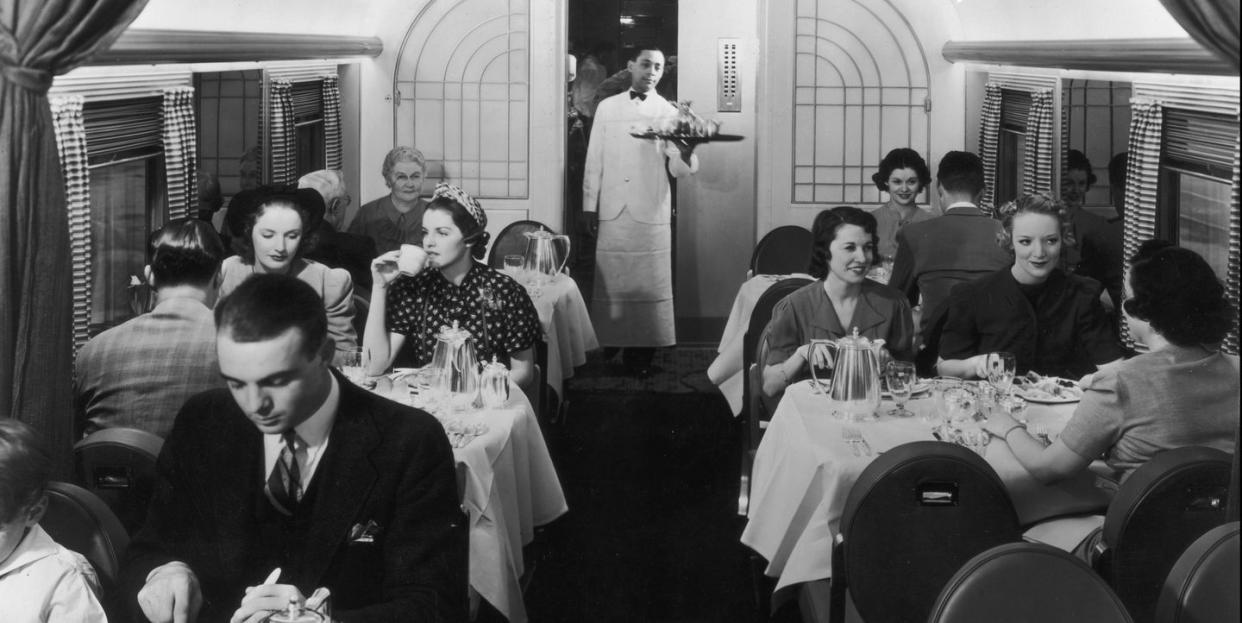Dining Cars Have Been Around Since the 1800s. Now They Face Extinction.

Traveling long distances by rail may be an increasingly old-fashioned mode of transportation in the U.S., but there’s still a sizable sect of passenger railroad diehards. And as some long-standing train traditions are in danger of disappearing, the devotees won’t go down without a fight.
Last month, the National Railroad Passenger Corporation (Amtrak) announced it would be phasing out the dining car service on many of its long-distance trains, chalking up the change to an Act of Congress under H.R. 749, the Passenger Rail Reform and Investment Act of 2015. By cutting the dining cars and staff in favor of more “flexible” dining options, Amtrak estimates it will save about $2 million a year, according to the Washington Post.
You can partially blame millennials for the move.
“Some people really like [the dining car] and view it as sort of a nostalgic train experience,” Peter Wilander, who leads Amtrak’s customer experience, told the Post. “Some people, especially our new millennial customers, don’t like it so much. They want more privacy, they don’t want to feel uncomfortable sitting next to [strangers].”
Under Amtrak’s new direction, it’s out with the classic dining car—complete with meal reservations, white linens, steak dinners, and friendly conversations with fellow passengers—and in with a complimentary menu called “Enhanced Flexible Dining” for sleeping car passengers (but not coach), consisting of pre-packaged meals prepared off-site, meant to be eaten in individual rooms. Coach passengers, meanwhile, can buy limited food items from the cafe cars or pack their own snacks.
On October 1, Amtrak officially instituted the changes on the East Coast’s Cardinal, City of New Orleans, Crescent, and Silver Meteor. The traditional dining service will remain—for now—on California Zephyr, Coast Starlight, Empire Builder, Southwest Chief, Sunset Limited, Texas Eagle, as well as the Auto Train between Lorton, Virginia, and Sanford, Florida.
Since Amtrak made the announcement, however, some rail passenger advocates have pledged to take a stand. As of this writing, more than 12,600 people have signed a Change.org petition urging Congress and Amtrak to keep the dining car service on all long-distance trains.
The petition comes from Gene Arenson, a member of the National Association of Railroad Passengers. As the east coast changes take effect, Arenson writes, “a 100 year tradition of meals served in the dining cars will end; the mid-west [sic] and west coast trains are sure to follow. And so will national rail travel as we know it, unless we speak up and be heard.”
The comments on the petition reinforce the fans’ passion for a beloved custom.
“We cannot let an icon of American railroading fade into history. After all, the Dining Car is a true part of the passenger railroad experience,” writes Coleen Williams from Rockwell, Texas.
“Amtrak isn’t so much about the destination, it’s about the journey,” writes Alan Tipping, of Mint Hill, North Carolina. “After all, if I want to get there quickly, I’d fly. The dining car is the best part of the ride,” says Alan Tipping from Mint Hill, North Carolina.
Sandra Jones from Woodland, California says, “The dining car is the highlight of my train travel. So many of the niceties our parents and grandparents enjoyed have been eliminated. It would be tragic if future generations missed out on the dining car experience and food that isn’t served on a foam tray with a plastic fork.”
Arenson and co. are hoping to collect 15,000 signatures to convince Amtrak to reverse course or, at the very least, give coach passengers the option to buy the same flexible dining foods as the sleeping car passengers.
You Might Also Like

